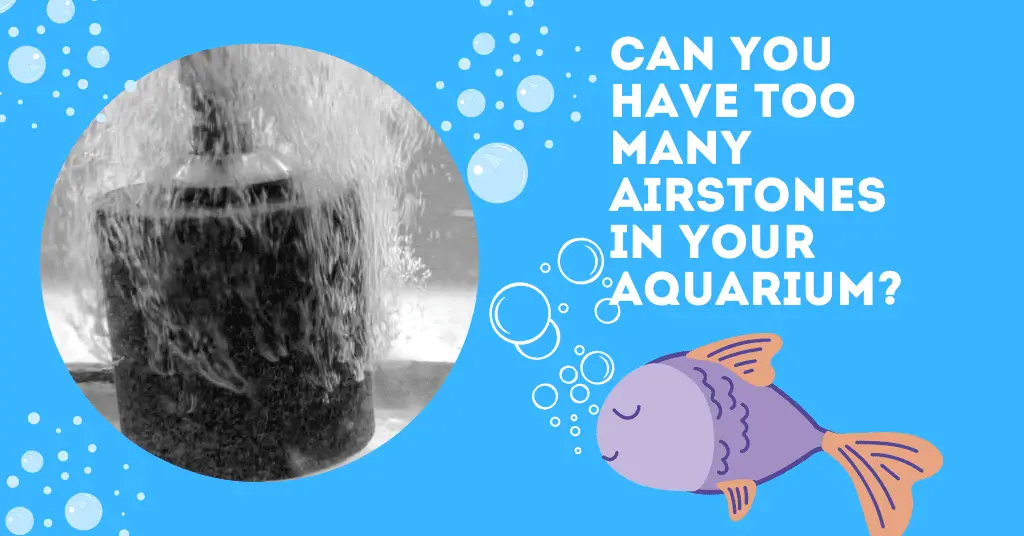Last Updated on November 17, 2021 by cmoarz
Ever been sitting in front of your aquarium lost in a deep trance watching your fish swim about the tank, where seemingly out of nowhere you suddenly start wondering if you’ve got enough airstones? Are my fish getting enough oxygen?
What about too many airstones? Is it possible to have too much aeration in a fish tank and how many stones do I need?
This article set’s out to solve these problems and give you the information you need in order to stop worrying and get back to enjoying your fish!

Can you have too many airstones in your aquarium?
Table of Contents
Right off the bat, we should answer the question. The answer is no, you can’t have too many stones in your tank. At least for oxygenation. Water turbulence will be a bigger factor here. It’s also possible to have air pumps that are too powerful for the aquarium it’s placed in.
This can be fixed by using a variable valve on the air line connected to the stone, or by splitting the power of the air pump to multiple stones in multiple tanks.

How many airstones per gallon is recommended?
In general, for a 10-gallon aquarium you probably only need 1 air stone with an air pump that can produce 0.330 Liters/minute of air.
A 20 gallon requires an air pump of 0.660 Liters per minute with 1 air stone.
As you increase the number of gallons in a tank, you should also double the amount of air going into that tank up to a certain point.
After that point, you want to start adding more air stones coming from a single air pump to help distribute the dissolved oxygen in larger tanks rather than just increasing the strength of the air pump itself.
When you connect a second air stone to an air pump, you are dividing the air power from the first stone and adding it to the second stone, So you aren’t getting more oxygen.
The air pump already has a set amount of oxygen it can move at any given moment, which is rated in Liters per minute.
By adding additional stones, you aren’t doubling your oxygen amount in the tank, But you are helping evenly distribute it better threw out the tank.
The goal is to have a dissolved oxygen level of at least 5-6 ppm in the water.
You can measure Dissolved Oxygen in water with a tool called a DO meter. These tools are often very expensive and you really don’t need one as a smaller aquarium hobbyist.
However, I’ve included a link for those of you who would like to purchase the tool for your larger tanks and fish rooms.

Signs of too much oxygen in a fish tank you should watch for
The maximum amount of dissolved oxygen that can be added to water is 14ppm. This is far above what is recommended and might be considered too much air for many fish.
With so much oxygen in the tank water, the aquarium plants will start to suffer. The oxygen will displace the carbon dioxide the plants need for photosynthesizing.
Aside from plants, certain types of fish may show signs of oxygen toxicity.
Common symptoms include labored breathing, clamped fins, and bright red gills.
You may also notice that your fish are staying near the surface of the water more often than they normally do which is an early indicator of too much-dissolved gases in the tank water.
(It’s also an indicator of not enough, That’s where a DO meter comes in. But common sense says if you have an airstone you probably aren’t suffering from a lack of oxygen).
Gas bubble disease is also something that’s noticeable, however, it’s very rare to happen just because of dissolved oxygen. Nitrogen and C02 injection are the number 1 leading cause of this issue.

Too many airstones effect on fish
it’s pretty hard to max out the dissolved oxygen no matter how much air you pump in. Especially if you have enough turbulence breaking the surface area of the water, bring in a lot of surface agitation, and breaking surface tension allows gas exchange to happen.
This tends to be a natural side effect when the air bubbles come to the water surface. The bubbles breaking also cause water movement. Smaller bubbles will do the same as bigger bubbles, but to a lesser degree more rapidly, So removing the airstone and just having an air hose is going to have the same effect.
That’s when all that dissolved oxygen in the water leaves from the surface of the water into the atmosphere due to sufficient surface agitation.
So any oxygen you put in will eventually become atmospheric oxygen. The two are one and the same, to begin with.
The more immediate effect on fish is the drastic increase surface agitation your fish will experience. This also includes strong currents that fish will have to fight against.
Some fish like strong currents but many do not. It can even kill them from the exhaustion of trying to fight it.

How important are airstones and what happens if you don’t have any at all
So on the other side of everything, You have no airstones at all. What happens then?
Well “not much” is usually the answer. You don’t need an air pump or anything in your tank to have dissolved oxygen available for your fish.
oxygen can also be placed into the water column via a high-up filter flowing water from the surface (breaking the surface).
You can also have a sufficient amount of plants to produce oxygen.
However, for some fish, this won’t be enough. Fish like betta’s and corydoras and other labyrinth fish can have no oxygen in the water and they can do just fine because they come to the surface to breathe.
However, Other fish that do have only gills to breathe require sufficient oxygen. Plants and generous surface agitation might not always be enough.
Go on youtube and you can yourself see all the videos of people who’ve lost entire tanks of delicate fish because their pumps turned off overnight.
With that said, You should always have an airstone in my personal and professional opinion. The effort and cost are minimal at best, it keeps the water moving slightly and gives your fish more than enough oxygen to breathe and be healthy.
About
Owner of AquariumGravel.com and also owner of actual Aquarium Gravel believe it or not! ;). Setting up beautiful aquarium sceneries and habitats since I was very young. Enjoy!
- Web |
- More Posts(290)

